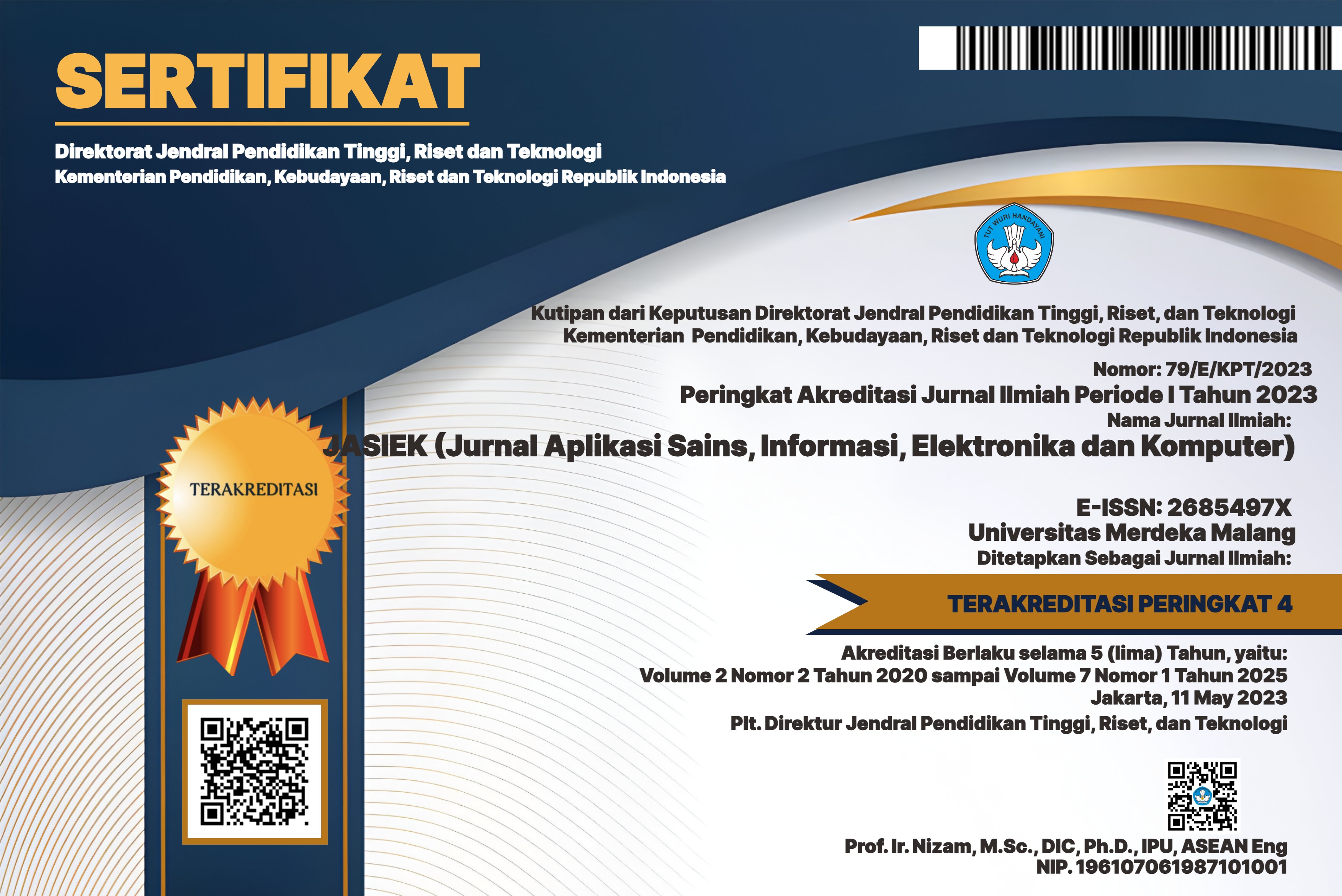Rancang Bangun Alat Penata Wafer Stick pada Mesin Mini Cutter
DOI:
https://doi.org/10.26905/jasiek.v7i2.11251Keywords:
wafer stick, arduino uno, sensor inframerah E18-D80NK, motor servoAbstract
Efisiensi produksi penting bagi perusahaan untuk mengurangi lost produksi, mesin produksi manual masih memiliki kelemahan khususnya pada lubang masuk produk ke mesin minicutter. Oleh sebab itu diperlukan penambahan proses guna mengatasi hal tersebut. Sebuah alat penata wafer stick dengan pengaplikasian sensor inframerah E18-D80NK dengan board Arduino Uno. Alat ini menggukan motor servo SG90 sebagai pembuka dan penutup plat penahan dan LCD 16x2 sebagai penghitung. Penelitian ini menggunakan sampel wafer stick dengan panjang 9cm, diameter 0,8cm. Hasil pengujian, menunjukkan bahwa alat ini bekerja dengan baik dengan waktu proses kurang dari 1 detik.Downloads
References
[1] A. Kristiyanto, S. S. Dahda, dan M. Z. Fathoni, “analisis efektivitas mesin packing tepung terigu kemasan 1 kg dengan menggunakan metode overall equipment effectiveness di pt. xyz,” JUSTI (Jurnal Sistem dan Teknik Industri), vol. 2, no. 1, 2021, doi: 10.30587/justicb.v2i1.3181.
[2] E. Krisnaningsih, “Usulan penerapan tpm dalam rangka peningkatan efektifitas mesin dengan oee sebagai alat ukur di pt xyz,” PROSISKO: Jurnal Pengembangan Riset dan Observasi Sistem Komputer, vol. 2, no. 2, 2015.
[3] A. Husain, D. C. Siregar, dan S. H. Permadi, “Alat Penghitung Barang Secara Otomatis Menggunakan Sensor Infrared Berbasis Arduino Uno,” Journal CERITA, vol. 6, no. 2, 2020, doi: 10.33050/cerita.v6i2.1160.
[4] A. Taupiko, Z. Azmi, I. Ishak, dan M. Dahria, “Alat Penghitung Produksi Kotak Air Menggunakan Teknik Counter Berbasis Mikrokontroler,” Jurnal Sistem Komputer Triguna Dharma (JURSIK TGD), vol. 2, no. 1, 2023, doi: 10.53513/jursik.v2i1.7302.
[5] Y. A. Bahtiar, D. Ariyanto, M. Taufik, dan T. Handayani, “Pemilah Organik dengan Sensor Inframerah Terintegerasi Sensor Induktif dan Kapasitif,” Jurnal EECCIS, vol. 13, no. 3, 2019.
[6] R. G. Paramananda, H. Fitriyah, dan B. H. Prasetio, “Rancang Bangun Sistem Penghitung Jumlah Orang Melewati Pintu menggunakan Sensor Infrared dan Klasifikasi Bayes,” Jurnal Pengembangan Teknologi Informasi dan Ilmu Komputer (J-PTIIK) Universitas Brawijaya, vol. 1, no. 3, 2018.
[7] Muh. F. Wajdi dan M. Tandililing, “Implementasi Metode Research And Development (R & D) Pada Aplikasi Pengelolaan Arsip,” Jurnal Informatika Progres, vol. 14, no. 1, 2022, doi: 10.56708/progres.v14i1.320.
[8] R. Andarsyah dan R. Fadilla, “Aplikasi Lelang Online Geographic Information System (WEBGIS) Intelligence PT. Pegadaian (Persero) Menggunakan Metode Research and Development,” Jurnal Teknik Informatika, vol. 12, no. 2, 2020.
[9] L. Liesnaningsih, D. Kasoni, dan D. Djamaludin, “Prototype Robot Penyemprot Disinfektan Dengan Metode Research And Development,” JIKA (Jurnal Informatika), vol. 6, no. 2, 2022, doi: 10.31000/jika.v6i2.5914.
[10] M. Kusriyanto dan N. Wismoyo, “Sistem Palang Pintu Perlintasan Kereta Api Otomatis Dengan Komunikasi Wireless Berbasis Arduino,” Teknoin, vol. 23, no. 1, 2017, doi: 10.20885/teknoin.vol23.iss1.art9.
[11] H. Prio, “Sistem Kendali Perangkat Elektronika Berbasis Arduino Mega,” Seminar Nasional Sains dan Teknologi, no. November, 2017.
[12] M. Pranata, “Implementasi Sensor Infra Merah Dengan Jaringan Nirkabel Untuk Sistem Pemantuan Blower Kandang Ayam,” Jurnal Nasional Pendidikan Teknik Informatika (JANAPATI), vol. 9, no. 3, 2020, doi: 10.23887/janapati.v9i3.24798.
[13] D. Eridani, I. Sanusi, dan E. D. Widianto, “Pengenalan dan Analisis Ucapan pada Sistem Kontrol Perangkat Listrik Menggunakan Arduino Uno,” Jurnal Teknologi dan Sistem Komputer, vol. 6, no. 1, 2018, doi: 10.14710/jtsiskom.6.1.2018.18-24.
[14] M. Didi, E. D. Marindani, dan A. Elbani, “Rancang Bangun Pengendalian Robot Lengan 4 DOF dengan GUI ( Graphical User Interface ) Berbasis Arduino Uno,” Jurnal Teknik Elektro, vol. 2, no. 3, 2015.
Downloads
Published
Issue
Section
License
Copyright (c) 2024 JASIEK (Jurnal Aplikasi Sains, Informasi, Elektronika dan Komputer)

This work is licensed under a Creative Commons Attribution-NonCommercial-ShareAlike 4.0 International License.
Authors who publish with this journal agree to the following terms:
The journal allow the authors to hold the copyright without restrictions and allow the authors to retain publishing rights without restrictions.
Authors retain copyright and grant the journal right of first publication with the work simultaneously licensed under a Creative Commons Attribution-ShareAlike 4.0 International License that allows others to share the work with an acknowledgement of the work's authorship and initial publication in this journal.
Authors are able to enter into separate, additional contractual arrangements for the non-exclusive distribution of the journal's published version of the work (e.g., post it to an institutional repository or publish it in a book), with an acknowledgement of its initial publication in this journal.
Authors are permitted and encouraged to post their work online (e.g., in institutional repositories or on their website) prior to and during the submission process, as it can lead to productive exchanges, as well as earlier and greater citation of published work (See The Effect of Open Access).

This work is licensed under a Creative Commons Attribution-ShareAlike 4.0 International License.










